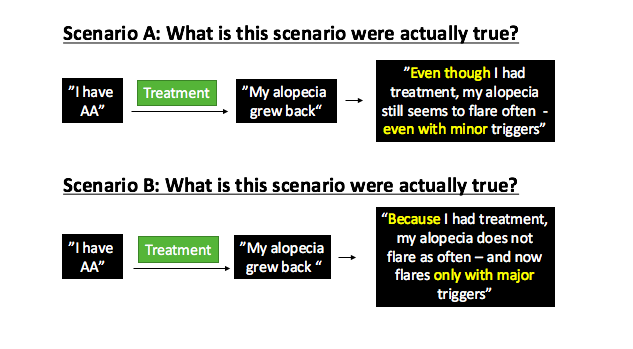Changing the Natural Course of Alopecia Areata (AA): Yes or No?
Can we change the “natural history” of alopecia areata?
When it comes to education surrounding the topic of alopecia areata, the classic teaching that any medical student, intern, dermatology resident, registrar and dermatologist learns – is that alopecia areata mainly governs itself and that no treatment actually changes its so called ‘natural course’. The term ‘natural course’ refers to the course the AA takes if the patient does not treat his or her hair loss. If alopecia wants to go away, it will go away. Yes, treatment might help it go away faster and sooner and treatment might help the hair stay on the scalp longer, but if hair wants to regrow it will regrow. If alopecia wants to come back in the future after the patient is done treatment, it will come back. No treatment is going to alter this. At least that’s the classic teaching we’re all taught.
Can treatment today alter the course of AA in the future?
It was about 1 year ago that I remember distinctly hearing a comment by a trusted and respected colleague about his view that treatment today could potentially change how a patient’s alopecia areata behaves down the road. In other words, treatment now could potentially change what alopecia does in the future. In other words, the treatment that I administer today could potentially affect the degree of hair loss a patient has not only in one month and also whether or not the patient is getting flares of their disease in 10 years. The argument of my colleague was that we should be aggressive in our treatment always – because it affects how the patient’s alopecia acts in the future. And so, when I heard the comment I assumed that somehow my colleague had missed the ‘classic’ teaching. Perhaps my colleague did not know that supposedly no treatment could really change the natural course of alopecia areata.
Fast forward March 2, 2019 when another colleague Dr Rodney Sinclair in a lecture presentation at the American Academy of Dermatology Annual meeting announced his own hypothesis that treatment of alopecia could potentially alter the course of alopecia areata. He admitted he hadn’t proved it – but it was his strong hunch. As I heard his words, and saw his slides, I was reminded of the conversation I had with another world expert in alopecia areata just one year earlier. And the concept was now obvious to me: there is a clear interest in exploring whether the treatments we administer affects how the alopecia areata acts way down the road.
The hypothesis of Dr Sinclair was that we might consider aggressively treating our patients with alopecia. We should be aggressive not only so the patient can have more hair in the next few months but so that he or she might be less likely to have a flare of the disease next year or well into the future.
The hypothesis also has important implications for children with alopecia areata. We currently have the view that if a child’s alopecia areata wants to be aggressive in its course and hair loss wants to come back again in the future – it’s simply going to do so. Sinclair’s views, however, offer a different view and a different hope. His views are that by considering offering the patient aggressive treatments before the child walks out the door that same day – that we might drastically affect the course of his or her alopecia.
Conclusion
We’ve had many paradigm shifts in how we think about alopecia areata in recent years and quite possibly we could be onto yet another one. More studies are needed to determine if treatment of alopecia affects the patterns of hair loss the patient has years down the road.
This article was written by Dr. Jeff Donovan, a Canadian and US board certified dermatologist specializing exclusively in hair loss.

